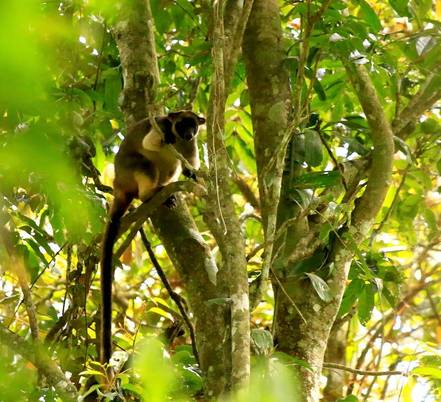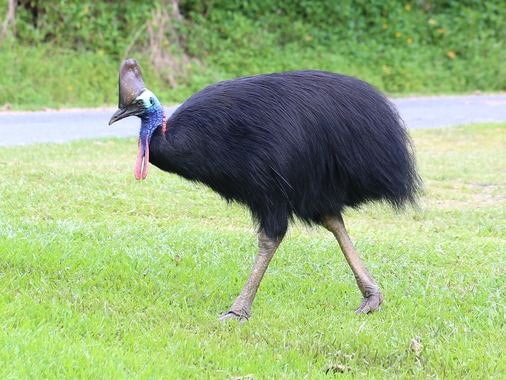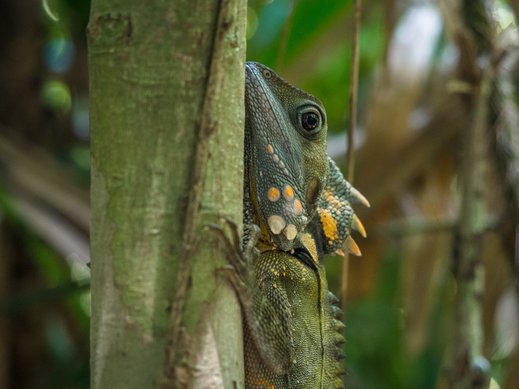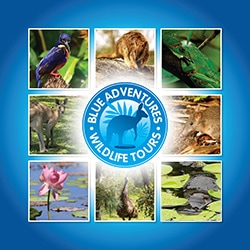|
When people imagine a rainforest they dream up a misty, humid, dense jungle, rich in wildlife such as monkeys and orangutans, jaguars and leopards, toucans, Boa Constrictors and millions of bugs... Well the Wet Tropics rainforests close to Port Douglas and Cairns are misty, humid and contain millions of bugs but our wildlife is very different to what most people imagine! Think kangaroos that live in trees, large flightless birds that can grow to nearly 2 metres tall and one of the world's most unusual animals, the platypus. No monkeys or big cats in Australia and our version of the boa-constrictor, the Amethystine python, puts most other snakes to shame as it grows to an astonishing 7+ metres! The rainforest we explore is an internationally recognised biodiversity hotspot containing an extremely rich variety of plants and animals. A few stats about what can be found in the Wet Tropics World Heritage area:
What many visitors to the Wet Tropics rainforest don't expect is that most of the wildlife is nocturnal (active at night) or crepuscular (active at dawn and dusk). It takes patience, persistence and plenty of local knowledge to know where to find rainforest animals during the day. Most rainforest tour operators don't have the time in their schedules to patiently wait for wildlife or the flexibility to change where they visit dependant on what their guests would like to see. Our private wildlife and rainforest tours focus on viewing wildlife and can be adapted to your preferences. Below is information on a few of the more unique animals that we can see in the rainforest on our tours.  A Lumholtz Tree kangaroo resting high in the rainforest canopy. A Lumholtz Tree kangaroo resting high in the rainforest canopy. The Lumholtz Tree kangaroo These shy, nocturnal animals can often be spotted during the day asleep or resting high in the rainforest canopy. Preferring to climb rather than hop, the Lumholtz Tree kangaroo has developed long and muscled forearms while its hind-feet are short and broad, allowing the feet to mould arrange branches and tree trunks. One very noticeable adaption of the Lumholtz Tree kangaroo is the length of its tail relative to its body size. The long tail allows the kangaroo to balance when walking or resting on tree branches however it is not used to wrap around branches like the tail of a monkey. The Lumholtz Tree kangaroo is only found in the rainforests of tropical north Queensland.  By Summerdrought (Own work) [CC BY-SA 4.0], via Wikimedia Commons By Summerdrought (Own work) [CC BY-SA 4.0], via Wikimedia Commons The Southern cassowary A relic from the age of dinosaurs, an adult cassowary stands as tall as a human and is Australia's heaviest bird at up to 85 kilos. The Southern cassowary is only found in north Queensland and numbers just a few thousand in the wild. Although they are nearly 2 metres tall and feature a brilliant blue and purple head and neck, the cassowary is hard to spot in the wild and is only very occasionally seen in the area around Port Douglas. Feasting on a large variety of fruits, nuts and seeds, the cassowary is known as the gardener of the rainforest and is vitally important for the dispersal of seeds and the health of the rainforest. One of the cassowawy's striking features is the large helmet, officially knows as a casque, on its head. Scientists are still unsure of what exactly this is for but it may be used to pick-up very low frequency calls through the rainforest or to indicate dominance.  A Boyd's Forest Dragon seen at Mossman Gorge. A Boyd's Forest Dragon seen at Mossman Gorge. Boyd's Forest Dragon Well camouflaged and masters of silent movement, the Boyd's Forest dragon is active during the day but hard to spot with an untrained eye. This species is endemic to the rainforests of north Queensland Spending much of their day silently perched on tree trunks, at around head-height, these stealthy lizards are sit-and-wait predators that will ambush invertebrates that unwittingly come to close. Only very occasionally will the lizards come drown from a tree and roam on the ground. Forest Dragon's are most commonly seen during the warmer months and in the cooler months the lizards often retreat in to the rainforest canopy. For photographers the Boyd's Forest dragon is a very photogenic but incredibly frustrating subject. Just as you line up your photo the lizard has a habit of silently moving to the other side of the trunk and out of your sight. If you are planning on visiting Cairns or Port Douglas contact Blue Adventures to organise a day out viewing the extraordinary native wildlife we have in our region.
0 Comments
|
AboutWith World Heritage rainforest and Outback Queensland on our doorstep, Port Douglas is ideally situated to explore tropical north Queensland. Archives
April 2017
Categories
All
|

 RSS Feed
RSS Feed